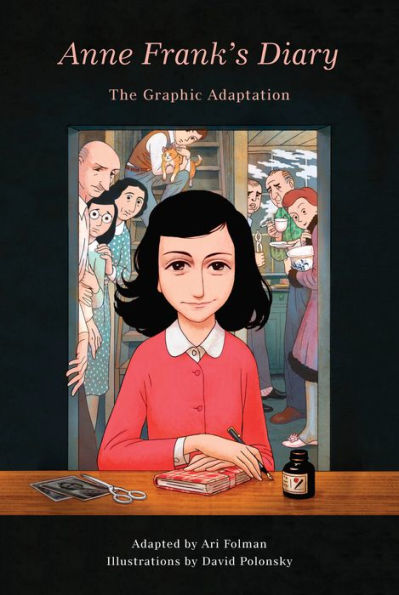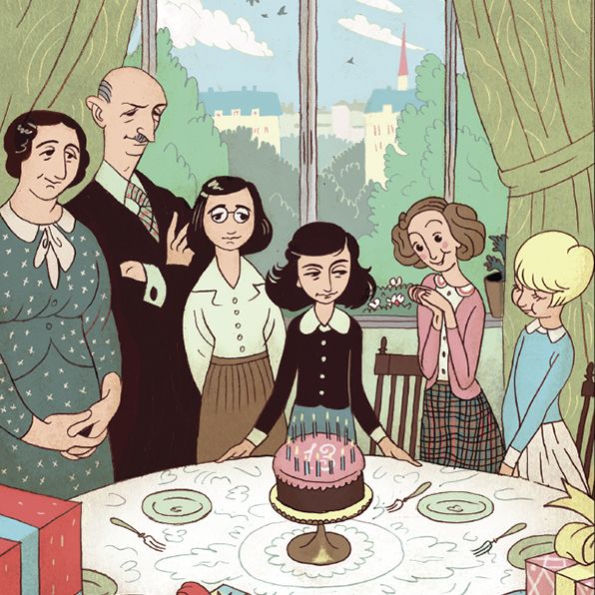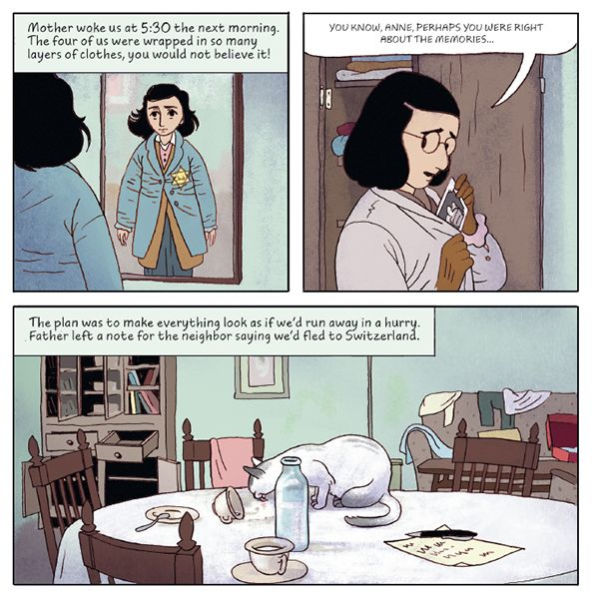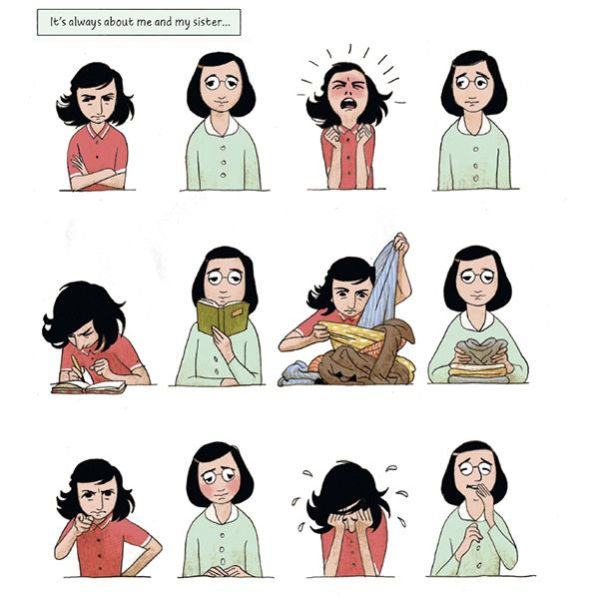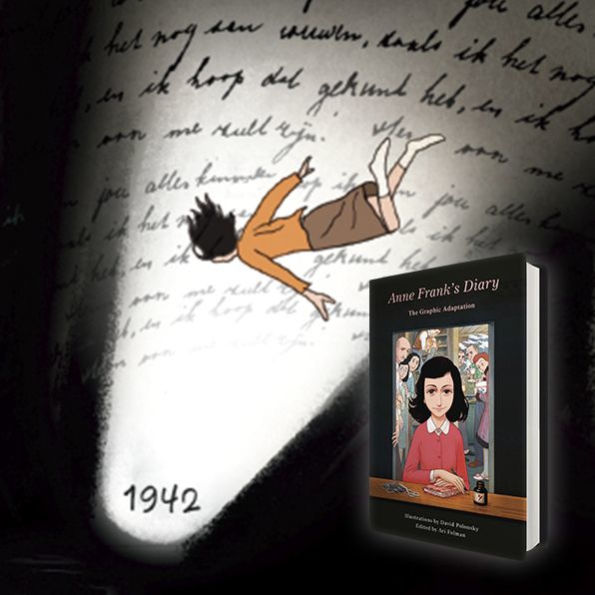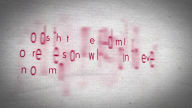★ 06/25/2018
The classic, original text of Frank’s diary is, as Folman writes in his adapter’s note, impossible to improve upon; instead, he and Polonsky (cocreators of the film Waltz with Bashir) focus on illuminating its humor, insight, and supporting cast in this spirited graphic adaptation, authorized by the Anne Frank Foundation. German Jews living in Holland, Anne and her family go into hiding in the “Secret Annex” behind her father’s business in 1942. The sequential art allows readers to get a visual diagram of the apartment shared by Anne and seven other residents. Outside, every allied victory ironically makes the Franks’ lives harder, as Nazi occupiers clamp down on dissidents. Inside, Anne, drawn with large dark eyes, blooms like the hardiest, loveliest weed—a moody teenager whose wit, self-awareness, and rich fantasy life take center stage. In one dinner scene, Polonsky draws Anne’s mother as a sheep keening for “those poor people starving in the Eastern camps,” while her angelic, bespectacled sister, Margot, is an owl who insists, “I feel full just by looking at others.” The narrative devotes ample time to Anne’s romantic feelings and sexual questions. The adaptors of her story take her seriously, but not more seriously than she took herself. The beauty of Anne’s life and the untarnished power of her legacy—here further elevated by Folman and Polonsky—are heartening reminders of the horror of her fate. (Oct.)
[A] stunning, haunting work of art. . . . The comedy of the Diary—one of the book’s most charming and often overlooked aspects—shines in this form. . . . There are so many wonderful juxtapositions of text and imagery that it feels cruel to focus on only a few, but another consistent standout is the way the graphic novel conveys Anne’s fantasies and emotions—so crucial to the Diary. . . . This graphic adaptation is so engaging and effective that it’s easy to imagine it replacing the Diary in classrooms and among younger readers.” —The New York Times Book Review
“Mr. Folman has succeeded in capturing the humor and vitality of the diaries—the hilarious sarcasm, the passionate declarations, the contemplative self-reproach—without a trace of retrofitted sentimentality. He owes much to David Polonsky’s sublime illustrations. Every one of Anne’s flights of fancy finds a thrilling and ingenious visual representation. . . . A wonderful, full-page composite image of Anne in her many moods—dreamy, snarky, silly, pensive, outraged or lovesick—is a reminder that the diaries are less about a life’s senseless destruction than about a brilliant young woman eternally coming into being.” —The Wall Street Journal
“Anne Frank’s Diary: The Graphic Adaptation is a masterpiece. Writer Ari Folman and illustrator David Polonsky have produced a vibrant, sensitive portrait of the icon who hid with her parents, sister and four others for two years in the annex of the building in Amsterdam that housed her father’s business. Through text and images of seamless intelligence, Anne emerges as a wryly sophisticated, maturing young lady. . . . Folman expertly balances Anne’s exterior and interior observations. While not minimizing her terrifying circumstances, he focuses more on her wisecracks than on her fears. . . . Polonsky’s extraordinary imagination and draftsmanship propel Anne’s revered diary. . . . This graphic novel is a valuable extension to all the literature that has emanated from Anne Frank’s diary.” —Hadassah Magazine
“In the handling that Folman and Polonsky give it, what happens is nothing short of a revelation . . . nothing has ever quite captured the strange, stubborn delicacy, the forlorn wistfulness, of the diary like this before . . . a genuine work of art.” —Christian Science Monitor
“Anne Frank's immortal journal gets a new visual energy from David Polonsky's breathtaking artwork. The story is devastating as ever, with Anne's romantic yearnings, adolescent rebellion and razor-sharp wit still shining through.” —Family Circle
“How does one breathe new life into a tale that is now so familiar that it risks losing its power to shock and instruct? Folman and Polonsky, the duo behind the film Waltz with Bashir, use the right tools to show us how it's done. Some may ask why Anne Frank's story needs a graphic adaptation, but the beauty of these pages provides the answer. It gives readers a strong visual idea of what Anne's secret annex behind a bookcase was like, where she struggled to make sense of her short and tragic life. Another panel shows a hypothetical wedding day that will break your heart all over again.” —Lindsay Pereira, HuffPost
“Ari Folman, the Israeli director of Waltz with Bashir, takes the moving words of Anne Frank’s The Diary of a Young Girl and, with his Bashir art director David Polonsky, creates an engaging, poignant coming-of-age journey. With its cartoon style, imaginative storytelling and teenage Anne’s wide-eyed mood swings, this adaptation leans kid-friendly.” —USA Today
“I wanted to dislike Anne Frank’s Diary: The Graphic Adaptation because books about Anne usually feel opportunistic or simplistic. But this comic-book version, authorized by the Anne Frank Foundation, is a monumental achievement. In large part that’s because it wears its importance lightly. . . . [I]t captures Anne’s teenage-ness: her love of drama, her rabid jealousy of her perfect sister, Margot, her appreciation of the physical comedy provided by the tacky van Daan adults. She feels like a real person, not a symbol. And there’s so much humor in these illustrations! Polonsky draws kinetically, varying panel size and bringing in little jokes and references from art history and advertising. He draws Anne with mobile, animated features and huge eyes. Folman nimbly provides historical context the original diary lacks; this version clarifies what was happening in the outside world as Anne was writing. But Folman also includes several full pages of unfiltered, unillustrated diary pages, showing real respect for Anne’s writerly voice. In an afterword, Folman says he only used 5 percent of the entire original diary; it feels like much more.” —Tablet
“Folman and Polonsky have reclaimed Anne Frank in all of her humanity, and they allow us to witness for ourselves her beauty, courage, vision and imagination, all of the qualities that make her life and early death so heartbreaking. And, in doing so, they have elevated the tools of the comic book to create an astonishing work of art.” —Jewish Journal
“Folman and Polonsky . . . focus on illuminating its humor, insight, and supporting cast in this spirited graphic adaption . . . Anne, drawn with large dark eyes, blooms like the hardiest, loveliest weed—a moody teenager whose wit, self-awareness, and rich fantasy life take center stage . . . The beauty of Anne’s life and the untarnished power of her legacy—here further elevated by Folman and Polonsky—are heartening reminders of the horror of her fate.” —Publishers Weekly, *starred review
“[W]itty, ironic, even snarky—Anne’s writing has an acerbic sense of humor. This adaptation is first and foremost a remembrance of that Anne, who, despite living a life marred by tragedy, tried by indignities, always held true to herself. Light touches of historical context, woven in through diary entries, provide necessary background without coming across as overly didactic. The whimsical nature of Polonsky’s illustrations . . . are unexpectedly moving: though we never lose sight of the gravitas of Anne’s story, these forays into fantasy, which show Anne escaping from the harsh present into a future that will never come, serve to remind us of the truly human face of genocide. This is an exceptionally graceful homage to a story that deserves to be told for years to come.” —Booklist, *starred review
“A superb offering to read alongside the original, this adaptation lets its narrator's voice soar.” —School Library Journal
“Evocatively crafted, this comic brings Frank’s world to life for all ages but takes care to respect and prioritize the primacy of her story in her own words.” —Library Journal
“‘Even deep sleep brings no redemption,’ she writes. ‘The dreams still creep in.’ Those dreams bring out the best of the illustrations amid the depictions of the everyday confinement in which Anne, her family, and others are hiding. A different format distills and renews Frank's achievement.” —Kirkus Reviews
“Emphasizes the visual nature of Frank’s text . . . Bring[s] renewed vigor . . . Powerful . . . points us to the very gap, between what we, her readers, can imagine for her of her missed future, and what she would never have the opportunity to live through.” —Women’s Review of Books
“Folman highlights Frank’s passionate, almost moral commitment to independence, her anthropologist’s eye, her unique psychological insight and her profound understanding that pessimism devalues life . . . Above Polonsky’s elegant illustration of the adult Frank, Folman’s version of Frank’s text makes for a piercing epigraph.” —The Forward
“The wide range of Folman and Polonsky’s graphic ideas is mesmerizing. . . . Most strikingly of all, Polonsky takes the abundance of metaphors in the diary text literally and creates unforgettable panels that establish an expressive dimension and enable us to see the quality of Anne Frank’s writing in a fresh light.” —Frankfurter Allgemeine Zeitung (Germany)
“A masterpiece.” —Il Mattino (Italy)
“The illustrations display a serene, impressive objectivity, and when Folman and Polonsky give rein to their imaginations to provide a pictorial dimension for Anne’s feelings, they do so in an admirably skillful and charming manner . . . unfailingly striking an admirable balance that is poignant at every turn. The result is a remarkable reading and visual experience.” —Frankfurter Neue Presse (Germany)
09/01/2018
The diary of Annelies Marie Frank (1929–45) has been translated into more than 60 languages and is required reading for millions of students. Her musings on her burgeoning adolescence in hiding from the Nazis are at once immediately recognizable and absolutely tragic. This graphic adaptation, the first to be authorized by the Anne Frank Foundation, from Folman and Polonsky, who previously collaborated on the animated film Waltz with Bashir, stays true to the indomitable spirit of Frank's words while bringing fresh eyes to her circumscribed existence. Anne is drawn as cute and expressive (picture any smirking photograph of her on a book cover), while her housemates are seen through critical eyes, often as less than pleasant animals. Visions of her carefree past, bad (and very real) dreams of Nazi persecution, and hallucinatory moments staring down questionable foodstuffs emphasize the realities of both her interior and external world. VERDICT Evocatively crafted, this comic brings Frank's world to life for all ages but takes care to respect and prioritize the primacy of her story in her own words. [See Prepub Alert, 4/30/18; previewed in Jody Osicki's "Graphically Speaking," LJ 6/15/18.]—Emilia Packard, Austin, TX
2018-06-27
An illustrated abridgement of the Nazi-era classic.Anne Frank (1929-1945) as graphic-history heroine? Adapter and composer Folman and illustrator Polonsky (Animation and Illustration/Bezalel Academy of Arts and Design) worked together on the Oscar-nominated, animated documentary Waltz with Bashir. According to Folman, they were approached by the Anne Frank Foundation about adapting the diary into both "an animated film for children" and a graphic novel that would introduce it to a new generation of readers. He then faced a "significant challenge"—to render the whole diary in graphic form might take a decade to complete and some 3,500 pages, while a more manageable "edit" could feature only 5 percent of the original text. Though he opted for the latter course, the abridgment retains the spirit of the whole as the perceptive and increasingly self-aware teenager navigates the usual tensions of adolescence—puberty, romance, family issues—within a nightmarish retreat from the Nazi atrocities intensifying outside their secret hideout. She feels guilty about any everyday cheerfulness she experiences in the face of so much death and destruction, and she succumbs to bouts of depression despite her typical resilience. "Even deep sleep brings no redemption," she writes. "The dreams still creep in." Those dreams bring out the best of the illustrations amid the depictions of the everyday confinement in which Anne, her family, and others are hiding. They were captured toward the end of the war, after the end of the diary, when the gas chambers were on the eve of being dismantled. Though she wasn't aware of her fate, Anne writes with much awareness of not only herself, but a potential readership, with the literary aspirations of someone who feels she has "one outstanding character trait…a great deal of self-knowledge. In everything I do, I can watch myself as if I were a stranger."A different format distills and renews Frank's achievement.









